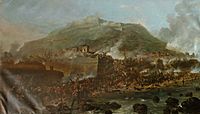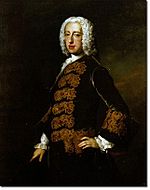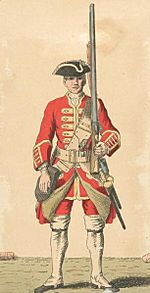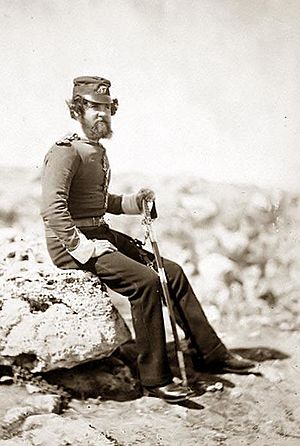47th (Lancashire) Regiment of Foot facts for kids
Quick facts for kids 47th (The Lancashire) Regiment of Foot |
|
|---|---|
| Active | 1741–1881 |
| Country | |
| Branch | |
| Size | One battalion (two battalions 1794–1795; 1803–1815) |
| Garrison/HQ | Fulwood Barracks, Lancashire |
| Nickname(s) | The Cauliflowers, The Lancashire Lads, Wolfe's Own |
| Colors | White facings, white lace |
| Engagements | 1745 Jacobite Rising Father Le Loutre's War Seven Years' War 1756-1763 American Revolutionary War Napoleonic Wars Third Anglo-Maratha War First Anglo-Burmese War Crimean War |
The 47th (Lancashire) Regiment of Foot was a famous infantry (foot soldier) regiment in the British Army. It was started in Scotland in 1741. This regiment fought in many important wars. These included the Seven Years' War and the American Revolutionary War in North America. They also took part in the Napoleonic Wars and the Crimean War. In 1881, it joined with another regiment to form the Loyal Regiment (North Lancashire). This happened because of big changes in the army called the Childers Reforms.
Contents
A Regiment's Beginning: 1741–1794
How the Regiment Started
The 47th Regiment began in Scotland in 1741. It was first called "Sir John Mordaunt's Regiment of Foot." This was named after its founder, Colonel Sir John Mordaunt.
In 1743, Peregrine Lascelles became the new Colonel. For two years, the regiment helped build a military road. This road was near Loch Lomond, connecting Dumbarton to Inverary.
Fighting in Scotland: The Jacobite Rising
In 1745, Charles Edward Stuart (also known as Bonnie Prince Charlie) started a rebellion in Scotland. This was called the 1745 Rising. Two companies (groups of soldiers) from the regiment guarded Edinburgh Castle.
The other eight companies fought at the Battle of Prestonpans in September. The government army was quickly defeated in less than 20 minutes. Most of the regiment's soldiers were captured. Colonel Lascelles was one of the few who managed to escape.
Later, Lascelles and other commanders faced a court-martial (a military trial). They were found innocent. The regiment was later re-numbered as the 47th Regiment of Foot in 1751.
Adventures in North America
The regiment moved to Nova Scotia in North America in 1750. Here, they were involved in conflicts between British and French settlers. These fights were sometimes called Father Le Loutre's War. They took part in battles like the siege of Grand Pré and the Battle of Fort Beauséjour.
During the Seven Years' War (1756-1763), the regiment joined forces with James Wolfe. They helped capture Louisbourg in 1758. This victory earned them the nickname "Wolfe's Own."
They also fought in the famous Battle of the Plains of Abraham in 1759. This battle was a key moment in the capture of Quebec. The regiment then helped capture Montreal in 1760. After the war ended in 1763, they returned to Britain.
The American Revolutionary War
In 1773, the 47th Regiment was sent to New Jersey when the American Revolutionary War began. They fought in the Battles of Lexington and Concord in April 1775. They also took part in the Battle of Bunker Hill in June 1775.
Later, they were involved in the Battles of Saratoga in September 1777. Most of the regiment was captured here. They were held as part of the "Convention Army" and did not return home for six years.
In 1782, the regiment was given a special name: the 47th (The Lancashire) Regiment of Foot. This name honored the county of Lancashire. In 1791, they went to the West Indies. A second battalion (another group of soldiers) was formed in 1794 but was soon disbanded.
Global Conflicts: 1803–1881
Fighting in the Napoleonic Wars

In 1803, a second battalion of the 47th Regiment was formed again. The first battalion went to the Cape of Good Hope in 1806. They then joined an expedition to South America in 1807. They fought in battles like Montevideo and Buenos Aires. In 1808, this battalion moved to India.
Meanwhile, the second battalion went to Gibraltar in 1809. In 1811, they joined the Peninsular War in Portugal. They fought bravely at the Battle of Barrosa in 1811. They also helped win the siege of Tarifa in 1811.
The battalion had a big victory at the Battle of Vitoria in 1813. They then took part in the very tough siege of San Sebastián in August 1813. Here, they lost many soldiers and officers. After this, they chased the French army into France. They fought at the Battle of the Nive in 1813 and the Battle of Bayonne in 1814. Finally, they returned home and were disbanded.
The Victorian Era: India, Burma, and Crimea
In 1817, the regiment was sent to India. They helped defeat the Pindaris in the Third Anglo-Maratha War. In 1819, they fought pirates near Ras al-Khaimah.
In 1824, they went to Burma for the First Anglo-Burmese War. They marched up the Irrawaddy River to the Kingdom of Ava. They returned to India in 1826 and then to England in 1829.
The regiment was posted to the Ionian Islands in 1850 and Malta in 1853. In September 1854, they landed in the Crimea for the Crimean War. They fought in the Battle of Alma in September 1854. They also took part in the Battle of Inkerman in November 1854. They endured the harsh winter during the siege of Sevastopol. The regiment returned to Malta in 1856 and England in 1857.
Defending Canada and Final Changes
In 1861, the regiment went back to Nova Scotia to help protect Canada. There was tension with the United States at the time. In 1866, they helped defend Canada against Irish-American ex-soldiers during the Fenian raids.
After this, they went to Barbados in 1868 and then to Ireland in 1870.
In the 1870s, the British Army made big changes. The 47th Regiment was linked with the 81st Regiment of Foot (Loyal Lincoln Volunteers). They shared a training base at Fulwood Barracks in Lancashire. On July 1, 1881, the two regiments officially joined together. They became the Loyal Regiment (North Lancashire). This marked the end of the 47th Regiment as a separate unit.
Battle Honors
Battle honors are special awards given to regiments for their bravery in battle. Here are some of the honors won by the 47th Regiment:
- Seven Years War: Louisbourg, Quebec 1759
- Peninsular War: Tarifa, Vittoria, San Sebastian, Nive, Peninsula
- Burmese Wars: Ava
- Crimean War: Alma, Inkerman, Sevastopol
Victoria Cross Hero
The Victoria Cross (VC) is the highest award for bravery in the British military. Private John McDermond from the 47th Regiment earned this award. He was given the VC for his brave actions during the Battle of Inkerman in 1855. He saved a wounded Colonel during the battle.
|





